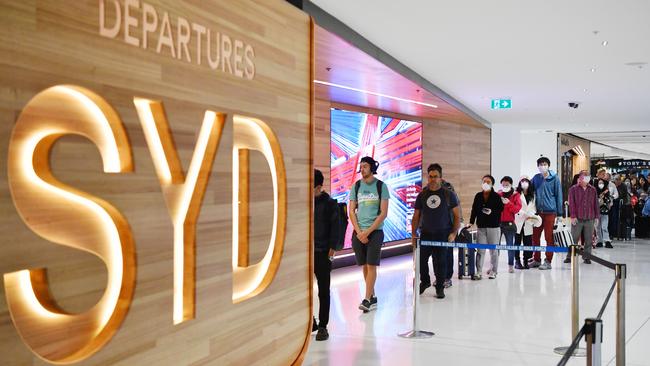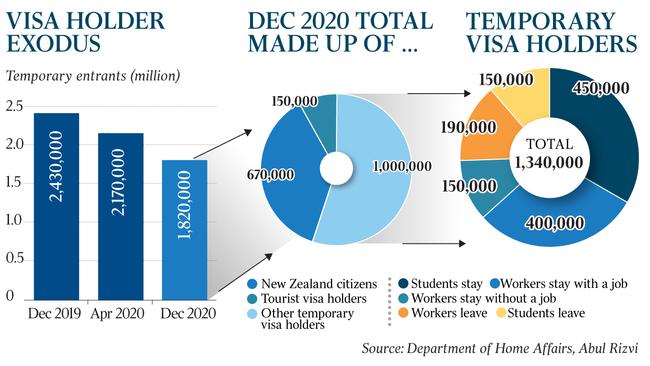COVID-19: Australia’s great exodus revealed
Coronavirus drives biggest population decline in Australian history, threatening to deepen spending slump and hit housing market.

The coronavirus is driving the biggest population decline in Australian history, with 300,000 tourists, temporary workers and students already departing this year in an exodus that threatens to deepen a consumer spending slump and hit the housing market.
The number of temporary visa holders in Australia dropped by 260,000 in the first three months of this year, with a further 50,000 departing in the first two weeks of April, Acting Immigration Minister Alan Tudge has revealed.
Research obtained by The Australian predicts a further 300,000 people could leave the country to return home by the end of the year, which economists warn could further erode consumer demand and cause a slump in the rental and housing markets.
Analysis by former senior Immigration Department official Abul Rizvi estimates that the number of temporary visa holders could drop to 1.82 million from more than 2.4 million at the start of the year. “We could be on the verge of the biggest percentage and absolute decline in our population since 1788, more than during the Great Depression or when we sent troops to the Somme,” Mr Rizvi said.
He estimated one-fifth of foreign students and one-quarter of temporary foreign workers would go home by the end of this year.

Australia’s population grew by 371,000, or 1.5 per cent, to 25.46 million over the year to last September, of which 63 per cent was due to net overseas migration.
Warren Hogan, a professor of economics at UTS Business School, said a large drop in net migration would sap consumer spending, already hobbled by the impact of nationwide lockdowns, and add further strain to a housing market grappling with a new national rental code.
“And when you look at it in turnaround terms, the drop is even bigger,” Professor Hogan said.
In the most recent budget, the government pencilled in net overseas migration of 271,000 this year, up from 259,600 in 2018. More than 800,000 net new immigrants were forecast over the next three years, the budget papers say.
Reserve Bank research by Peter Tulip and Trent Saunders, conducted last year, found a reduction in population growth would increase rental vacancies, trim rents and housing prices, and reduce construction.
Grattan Institute chief executive John Daley said weaker population growth would focus attention on the recent period of weak growth per capita.
“Per capita recessions will become real technical recessions”, Mr Daley said. “Total growth matters to Woolworths and Westpac and other businesses whose profits depend on population, but it doesn’t help the local gym instructor.”

Mr Tudge revealed that the total number of temporary visa holders in Australia had already dropped by 260,000 to 2.17 million in the first three months of the year, largely from tourists returning home as governments began to close borders to curb the spread of the coronavirus.
“We will almost certainly have fewer temporary migrants by year end as few are coming in while many are returning home as their visas expire or their work dries up,” Mr Tudge said.
Mr Rizvi said two decades of high temporary immigration had come to a “shattering halt”.
“If you look at the 1990s recession and 1980s recession, and after the Great Depression, two things stand out: net migration fell like a stone, and fertility fell,” he said. Mr Rizvi urged the government to provide greater support to the estimated 150,000 remaining foreign workers, who he said risked being left “destitute” without jobs in Australia.
“We won’t be able to run a ‘Where the bloody hell are you campaign’ ever again if we told everyone to piss off,” he said.
The US Federal Reserve bank late last year questioned the Morrison government’s boast that the Australian economy had enjoyed 28 years of uninterrupted growth, suggesting this had been achieved largely as a result of relatively high levels of immigration.
Josh Frydenberg told the ABC last week the government aimed to “grow the economy” out of the surge in debt that would result from about $214bn in new spending. The Treasurer pointed out that the economy was 16 per cent larger than when the Coalition was elected in late 2013.
The population had grown by 10 per cent since September 2013, or by 2.3 million people — the equivalent of another Perth and Wollongong — over that time.
“The last time we grew out of a big debt, after the war, we had a baby boom and post-war migration surge; neither are likely this time,” said Mr Rizvi, who is completing a PhD in the history of Australian immigration at the University of Melbourne.
Mr Tudge said this month it was “time to go home” for temporary visa holders who couldn’t support themselves. In a bid to contain costs, the government’s $130bn JobKeeper wage-subsidy scheme was limited to permanent residents. Labor had tried to include an extra 1.1 million casuals.
Bob Birrell, the president of the Australian Population Research Institute, said how government responded to the drop in migrants would be “pretty central to how Australia is going to evolve in the next few years”.
Mr Daley said huge uncertainty hung over how international travel would look in coming years. “We’re likely going to wind up in a world in which some countries have eliminated COVID-19 and some haven’t, and there’ll be a huge gulf between them, especially in terms of passenger traffic,” he said.








To join the conversation, please log in. Don't have an account? Register
Join the conversation, you are commenting as Logout